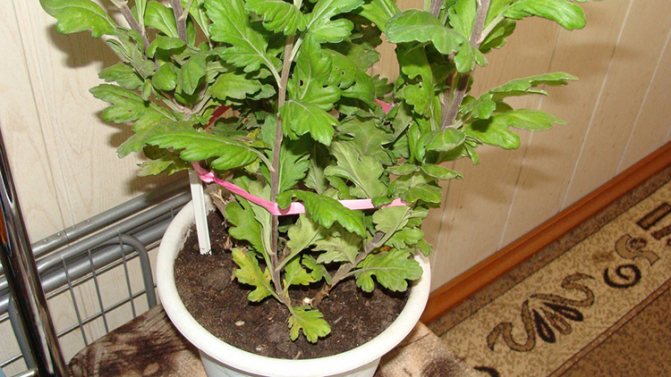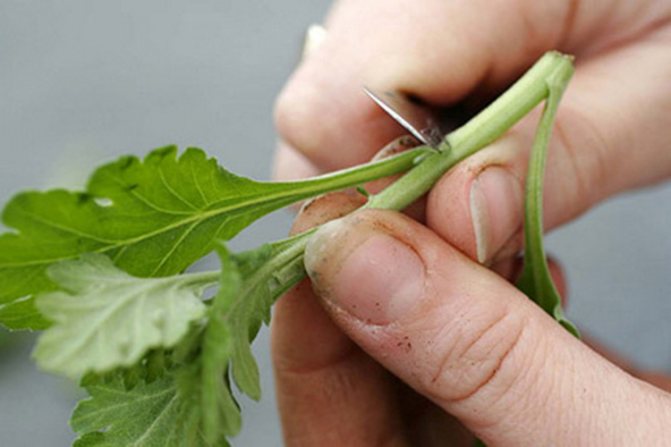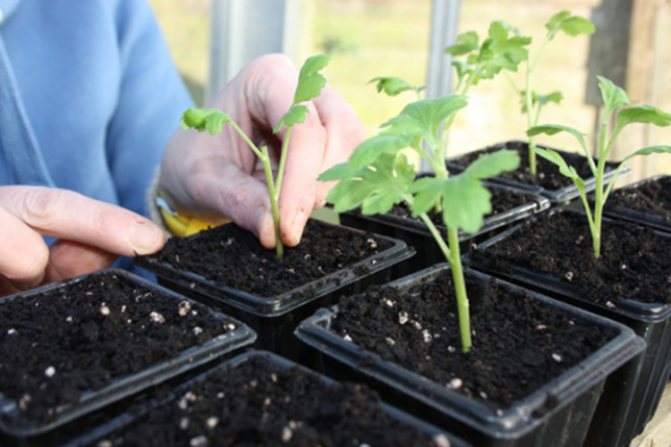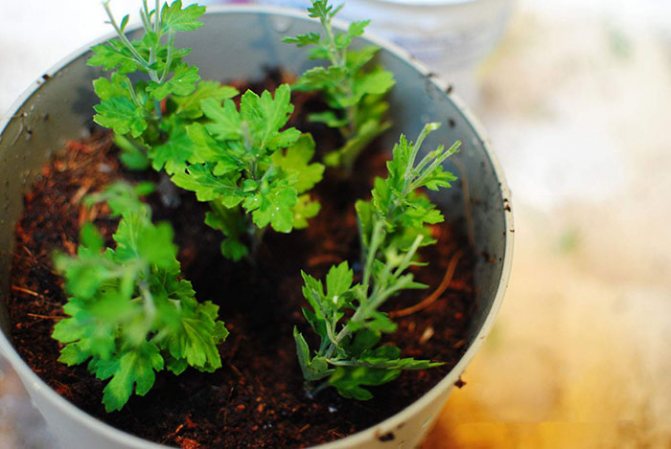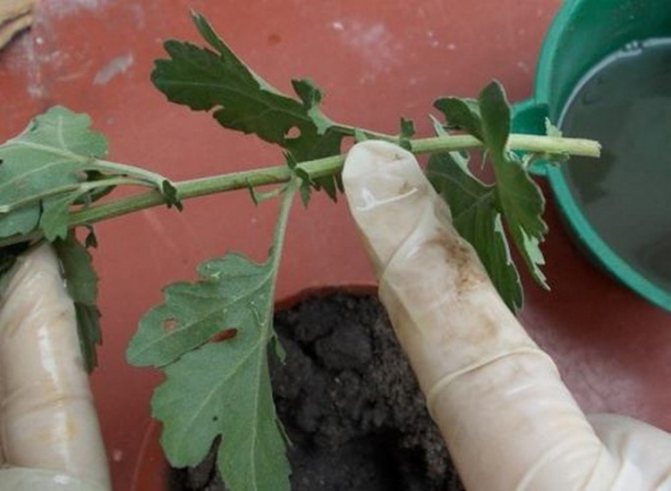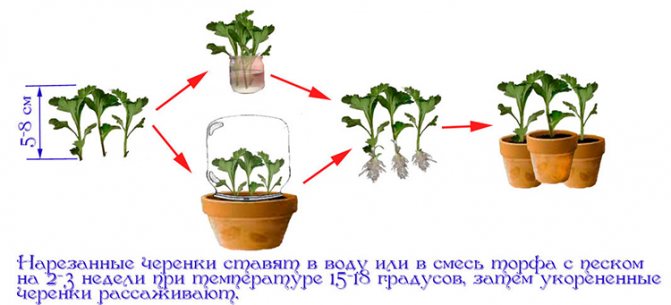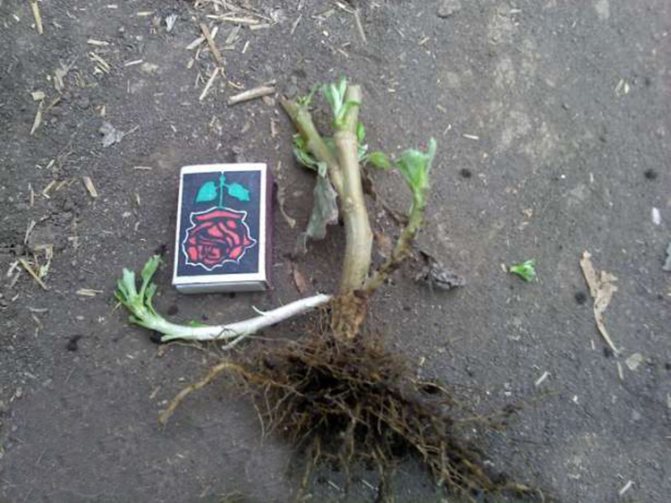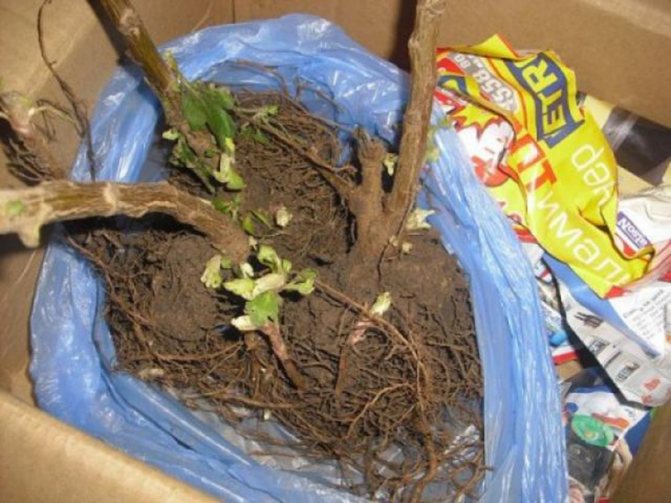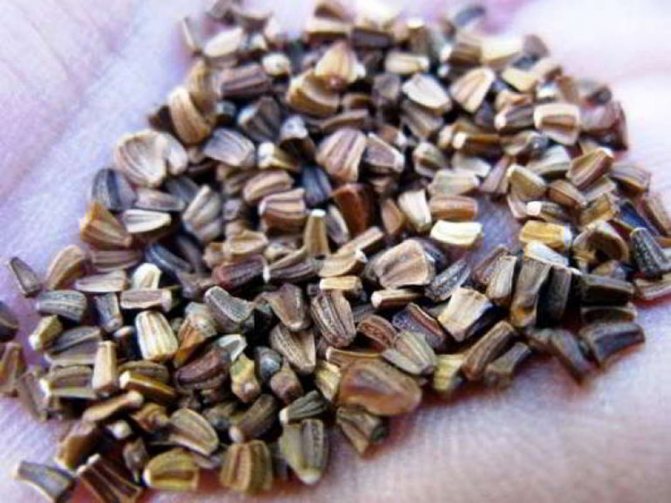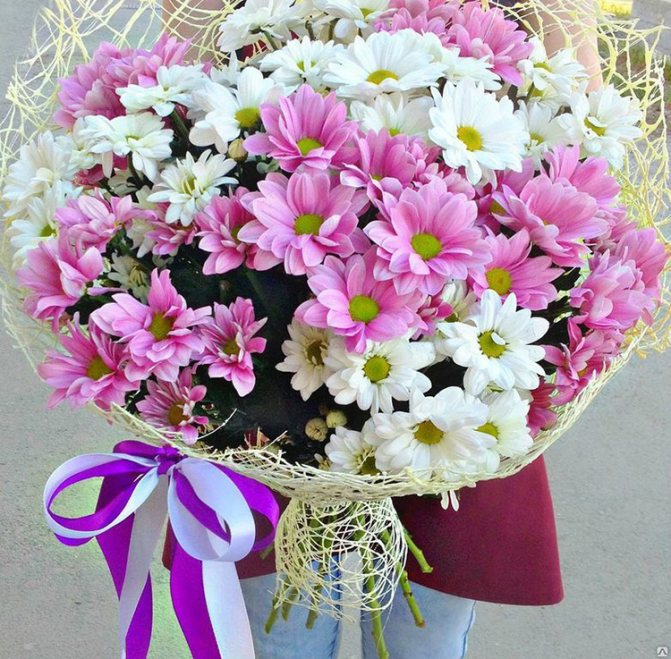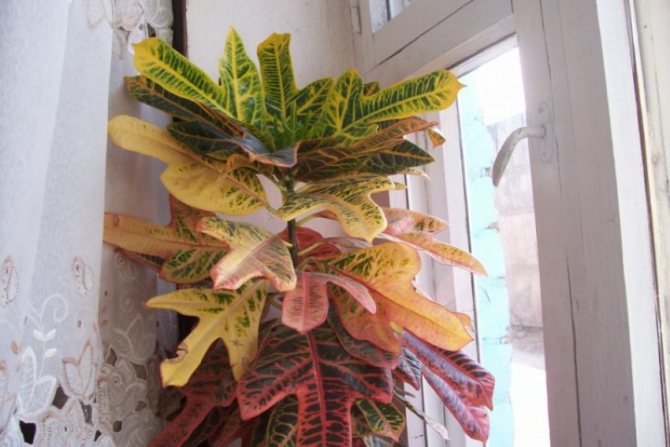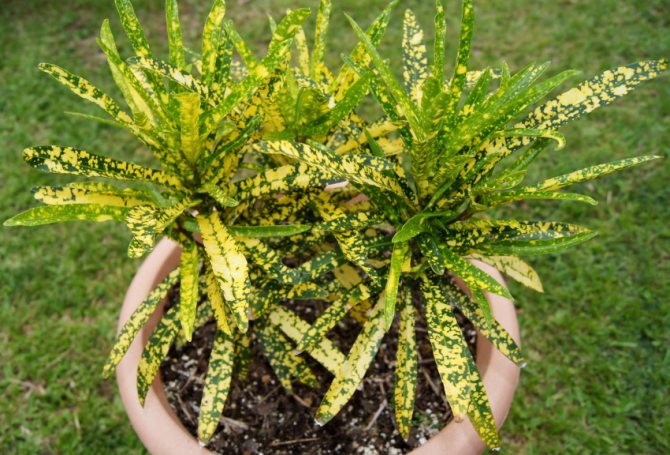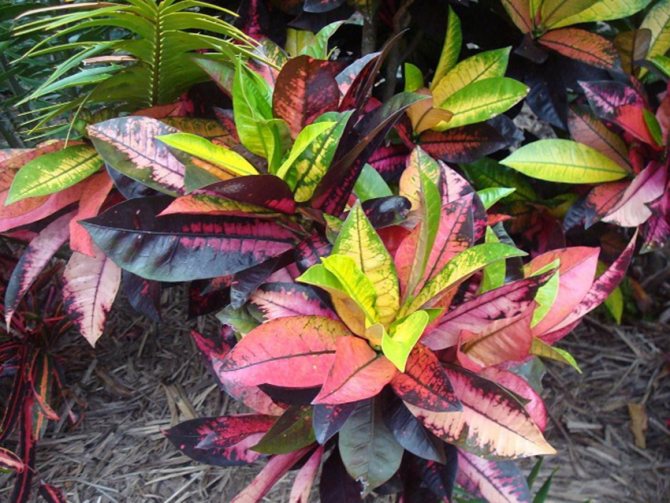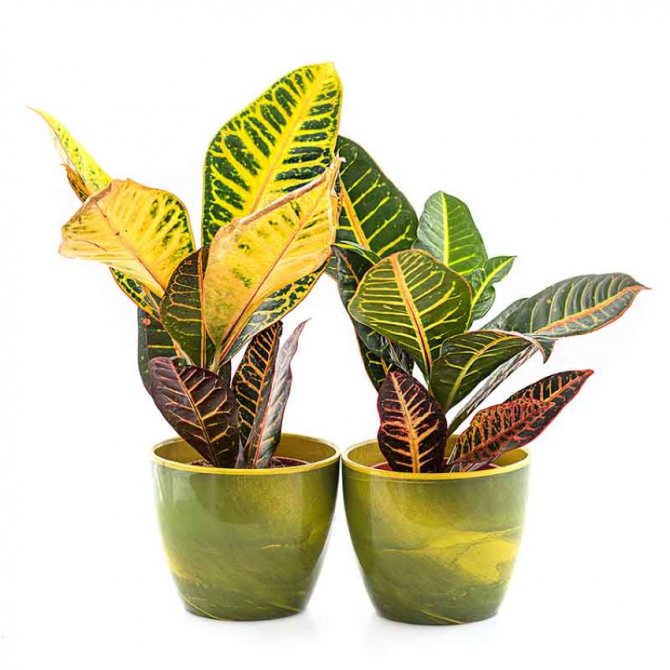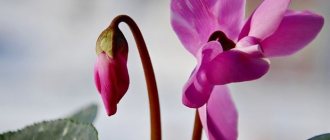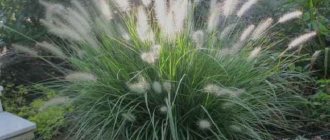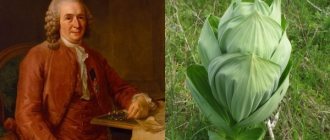The autumn lights of the lush annual flowers have long since faded. Perennials have prepared for wintering. And only the bushes of blooming chrysanthemums still delight the owners of the site with the magic of their beautiful, multi-colored inflorescences. It seems that, meeting the first frosts, they postpone the onset of winter, say goodbye to the past summer. The stems of the plant are decorated with green leaves, similar to oak, with bright flowers of any shade, which themselves ask for the last bouquets of the past season. These flowers are affectionately called oak trees, they have been known in Europe for several centuries. The best varieties of this plant with photos and names are given below.
Description and popular varieties of Dubka
Now about 65 0 species of chrysanthemums are known, united in 13 groups according to the types of inflorescences... Among them are pompom, feathery, bristly, spherical, anemone, simple, undersized, semi-double, terry types of plants. Perennial, annual species. Cold-hardy Korean chrysanthemums belong to one of the conditional groups. The list of varieties of Korean chrysanthemums contains a large number of colorful forms, despite the meaning of the word chrysanthemum as "golden-colored".

Korean chrysanthemums
Bush height korean chrysanthemums can reach 25, 130 cm. Inflorescences are formed from a large number of small flowers or several large ones, reaching 12 cm. Flowers can be in the form of a tube, tongue. Often up to 400 inflorescences, collected in a complex panicle, bloom on a bush... Erect stems have brittle twigs with numerous leaves. Their upper surface is smooth. The lower part is covered with light hairs. The branched root system, located at a depth of 20 cm, has shoots in the form of stolons, numerous shoots.
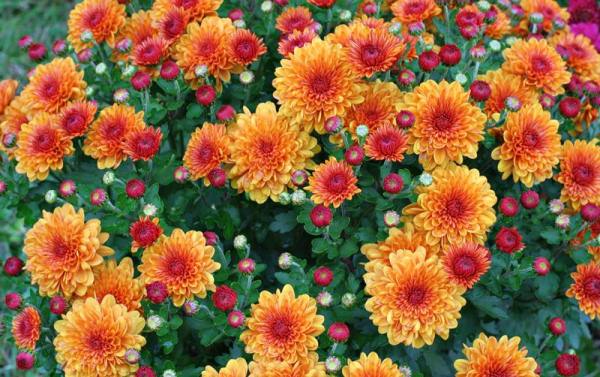

Terry chrysanthemum
Terry, semi-double varieties have a specific smell similar to the freshness of autumn fogs, not yet cold rains. If faded inflorescences are removed in a timely manner, then the total duration of flower growth on the stems reaches four months. Japan and China are considered the homeland of oak trees. In Russia, chrysanthemums began to be cultivated as a cultural perennial flower in the middle of the last century. There is evidence that the main set of modern varieties of "Korean hybrids" began as a result of crossing work carried out by A. Cumming in 1928.
Domestic breeders offer the following chrysanthemum varieties that have become popular:
Daisy
A strong bush, reaching a height of 70 cm, decorated with semi-double inflorescences of white flowers with a diameter of about 8 cm. The white color of the petals has a shade of yellow. Leaves are light green. The plant blooms at the end of August... Flowering lasts until the arrival of frost.
Valentina Tereshkova
In September, the raspberry inflorescences of a chrysanthemum bred in Crimea open... Against the background of juicy, large leaves, the bush looks solemn, elegant.
Autumn sunset
Already from the second half of August, you can admire the frost red inflorescences on a bush about 50 cm high ... The variety is pleasant to use in autumn bouquets.
Modesty
On a powerful bush at the end of August, white flowers with a delicate pink tint open up. The diameter of the flowers is about 6 cm ... The bush has a large number of leaves.
Vivat Botaniku
Blooms profusely for 65 days with yellow semi-double inflorescences... The height of the bush is about 55 cm. Flowering begins in mid-August.
Yellow-brown flowers are located on a bush, about 50 cm high ... The diameter of the flower reaches seven cm. As the buds open, their color changes from a raspberry hue to a brown, golden color.
Kibalchish boy
Low bush distinguished by bright red, double inflorescences.
Names and descriptions of perennial autumn flowers for flower beds
Perennials are the most popular choice for gardeners. They do not require complex and long-term care. There is no need to deal with seedlings annually. The main thing is to form a bush and check its condition.
Hydrangea
The shrub will make a new kind of flower arrangement in the garden. Huge balls against the background of autumn foliage and extinct grass can be compared to a miracle of nature, difficult to explain and fabulous magic. To preserve flowering in late autumn, special varieties have been developed. They do not require shelter and are afraid of frost. The first snow makes them even more magical.
Heather
An evergreen small bush is covered with scales. Heather pleases with red scales in summer and autumn. Even when it dries up and dies down, it does not change the colorfulness of its appearance.
Heather
Erika
The bush is practically indistinguishable from heather. But begins to bloom only in the middle of autumn
... The rest of the time is green. Erika inflorescences can be red, white, lilac and pink.
Amaranths
There are 3 types: paniculate, tailed, tricolor. Each variety is similar. Bard panicles are combined into a bouquet and stand in bright bunches among withered autumn grass. What is surprising is that falling under the snow, it does not lose its shape and appearance.
Amaranths
Hibiscus
The hybrid begins to bloom in July
, the last buds will open before the first frost. Bells are like butterflies that have flown in from another continent. The palette of colors is striking: white, red, lilac. Tropical colors will transform any garden plot.
Gomphrene spherical
Family - dried flowers. Dwarf varieties are very popular. The original purple cones cover the bush like candles on a New Year's Eve.
Hibiscus
Rules for the care of the Chinese chrysanthemum
Oaks belong to unpretentious flowers, the cultivation of which is considered not difficult. Normal, well-drained garden soil, ideal for growing. The plant does not withstand stagnant moisture... In such places, the probability of winter freezing increases. If there is clay soil on the site, then before planting it must be diluted with peat, humus, compost.
The best time to plant oak trees is spring. The distance between the planting holes is about 40 cm ... In addition to organic matter, a small amount of mineral fertilizers is added to their bottom. They are quite enough for two, three years of development of bushes. Plants grow quickly, transforming in one season from a small seedling into a spreading bush. This requires careful attention to feeding chrysanthemums.


The distance between chrysanthemums is determined depending on the variety.
The first feeding is recommended to be carried out two weeks after planting.... For this, nitrogen-containing fertilizers are used. During the budding period, it is recommended to apply potassium-phosphorus fertilizers. They are also used at the time of mass flowering of bushes. The plant is watered with an organic solution throughout the growing season. In the fall, after pruning the bush, it is useful to add organic matter around each bush along with bone meal, superphosphate. Florists consider ready-made preparations Aquarin, Omu flower, Gumi-Omi to be the best fertilizers for oak trees.
Watering is important for the quantity and preservation of flowers. With a lack of moisture, the stems of oak trees become lignified, the beauty of the peduncles decreases... Watered gently, trying to keep the water out of the leaves. In the fall, after pruning the bush, you need to make sure that there is no stagnation of water in the place of flower growth. The last measure of plant care is pruning, preserving hemp, about 15 cm high and shelter for the winter. For this, it is recommended to use sawdust, peat, spruce branches, dry leaves, stems of annual flowers. The winter shelter should not be tight.
Attitude to soil conditions
English oak, marsh and toothed oak are demanding on the mineral and organic richness of the soil. English oak grows best on normally moist, deep gray forest loams and on alluvial soils in the floodplains of large rivers; worse - on strongly podzol soils. With acidic humus, formed mainly with the participation of spruce, the oak dies, yielding to the dominance of the latter.
Large anthered oak grows well on dry, fresh, fertile soils. The reaction of the medium varies from slightly acidic to alkaline. Poorly tolerates even the slightest salinity and shading.
Marsh oak prefers moist soils, as it naturally grows on deep, moist soils of river banks and swamps.
The oak is red and is distinguished by undemanding soil fertility. The tree can withstand an acidic environment and should not be planted on calcareous or highly moist soils.
Mongolian oak reaches its best development on fresh, deep and fertile soils. But it can grow on soils of a wide range of fertility, including poor stony ones. On swampy and constantly waterlogged soils with high acidity, as well as in systematically flooded floodplains of rivers, oak does not grow.
Reproduction of oak trees
The plant can be propagated in the following ways:
By dividing the bushes
The procedure is allowed to be carried out throughout the growing season. Even at the time of flowering. The best time is considered to be the beginning of summer.... This is due to the intensive growth of young growth, good conditions for its transplant. It is dug up along with part of the old bush. A new bush has time to grow from each shoot with roots.
Pits for planting delenki are dug at a distance of about 30 cm from each other... Filled with compost, watered abundantly.
Cuttings
Oaks are a type of plant that easily grows roots on cut stems. Cuttings are planted in pots in the fall. Until February, they are kept under moderate watering conditions in a bright, cool room. The optimum temperature for keeping cuttings is about 6 ... At the end of February, they are placed in a warm room, watered, fed with nitrogen fertilizers at the rate of 25 g per bucket of water. After 20 days, the seedlings with the formed roots are transferred to separate containers filled with fertile soil. After reaching a height of 20 cm , remove the growth point by pinching the top.
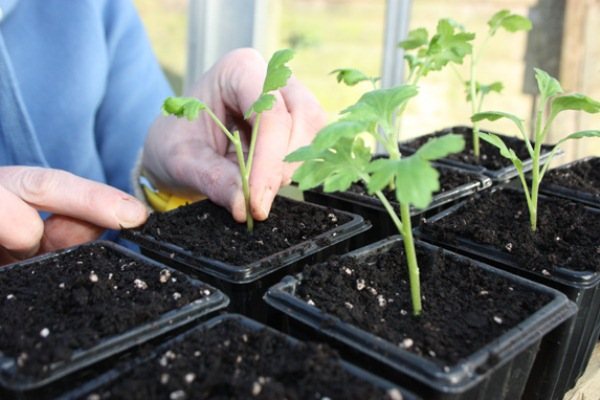

Planting cuttings Dubka
The second pinching is done after the lateral shoots grow back to a size of about 20 cm ... Top dressing is carried out by alternating different types of fertilizers. Before planting in open ground, the seedlings are hardened in the usual way. Cuttings are allowed to be done at any time, using shoots, side shoots, pieces of old stems. The first flowering of plants grown from cuttings of different periods begins almost simultaneously.
Seed reproduction
Seeds are planted in fertile soil at the end of February, March. The containers are covered with glass, creating a micro greenhouse... Seedlings appear in a week. After the growth of two true leaves, the seedlings dive into new pots.
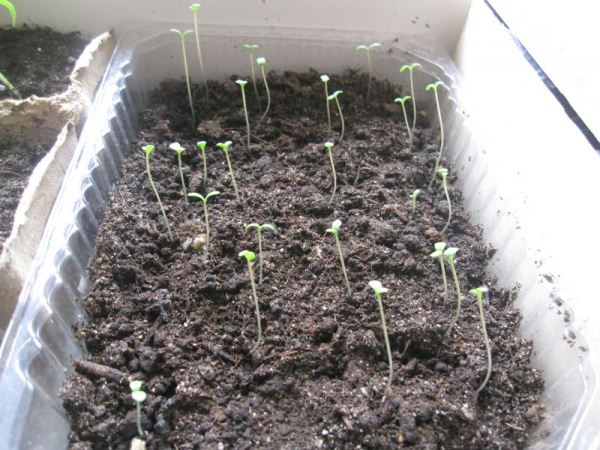

Features of the Korean Chrysanthemum (Dubka) make it possible to grow full-fledged plants from seeds
After two months, the height of young seedlings reaches 20 cm. Depending on the weather, they are planted in open ground in May.... Usually, flowering begins 5 months after planting the seeds. Seed propagation does not create stable plant forms. Its advantages include high resistance to wintering.
What to grow a tree from
You can get a healthy and strong plant from any planting material - an acorn or a cutting. In the first case, it will take more time; a tall oak will grow from a finished shoot 2-4 years earlier. The stalk must be prepared, the roots germinate. However, there is no guarantee that such a seedling will take root. It is easier to grow an oak from an acorn, therefore this method is preferred. The growth rate in the first 2-3 years is much higher than in subsequent years, so the process of monitoring development will become an exciting activity for young family members and hobby growers.


Flower pests and diseases
Many pests gladly settle on chrysanthemum bushes. Among them aphids, leaf rollers, slugs, snails, caterpillars, nematodes... Ash, dry mustard, herbal infusions, chemicals such as "Healthy Garden" will help you get rid of them in time. The same methods help the plant with diseases of powdery mildew, leaf spot, rust, chlorosis.
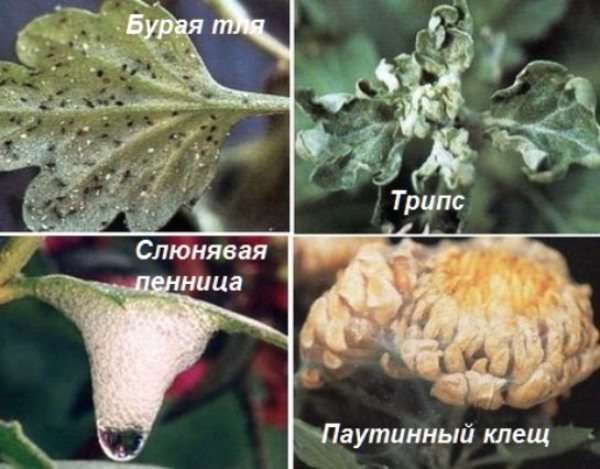

Common diseases of Dubka (Korean chrysanthemum)
Usually, many diseases develop with a lack of magnesium. In this case use Uniflor-butonour, Fitosporin, Zircon... Fungal diseases appear on plants with a constant excess of moisture.
An attentive attitude to chrysanthemums allows you to realize the most beautiful, long-blooming options for decorating the site. In late autumn, when all the work is completed, it is pleasant to think about new plans for the next season. surrounded by bright, beautiful flowers.
Chrysanthemums are a special mesmerizing world of flowers. They are so diverse that when you choose them, your eyes simply run up. After all, each of them is beautiful and incomparable in its own way. These are so gentle and strict at the same time; fragile, at first glance, and energetic firm, self-confident flowers. No wonder they are called "oaks". China is considered the birthplace of these flowers. Therefore, these flowers have another name - Chinese chrysanthemum.
Beautiful autumn wildflowers for flower beds and flower beds
Gardeners create a special decor using cereals that bloom in a particularly gentle way. In the last warm days, they will change the site, return the impressions of the first summer months.
Boutellois graceful
Externally it is a herb with a white cereal at the end.
White sticks (cereals) are bent at right angles. The bush is covered with white inflorescences. Sometimes it seems that the sticks are just hanging in the air, located on top of the grass.
Reed spine-flowered
The grain reaches 1.5 meters. It is placed along paths, fences. The bushes in front of the house look original. Designers suggest planting a reed tree for flowers.
When the summer fragrance and the play of colors are over, the cereal reaches its maturity. It starts to bloom. The pale greens of thin herbaceous leaves are covered with white-gold panicles, with a decrease in temperature the panicles become pink.
Reed spine-flowered
Moliniya blue
The strong, dense leaves of the field grass have no flowers, but the leaves take on a blue tint in the fall. Purple bright grass will overshadow the bright flowering bushes.
Broad-leaved flat grate
The stems of the plant are similar to bamboo foliage. During the summer season, they change color several times. By late autumn they turn gold. The inflorescences can be compared to hop cones,
but they are not bulky, but flat. The type of inflorescence is a lump smoothed with an iron. They also change their color: first green, then bronze, eventually pink or yellow.
Miscanthus
Miscanthus
The brown foliage is covered with silver and red buds. One gets the impression of flowering herbs, frosty silver.
Canadian goldenrod
Perennial field grass during the summer is modest and inconspicuous. In late autumn, the bush changes. It turns golden. Inflorescences consist of small baskets
... Brooms shimmer in the wind and make you dream and admire their beauty.
Liriope spikelet
Green leaves always remain the same color, imperceptibly some die off, others are born. Inflorescences appear in September.
Peduncles are covered with small purple buds - balls.
Chrysanthemum care
As you know, there are a lot of varieties of chrysanthemums. There are conditionally two types of chrysanthemums. They are large-flowered. They look very beautiful in bouquets. These flowers love warmth. And therefore they grow either in greenhouses, greenhouses or in the south. Such chrysanthemums are called Indian. The second type of chrysanthemum is Korean. They are grown both in personal plots and in pots, like houseplants.
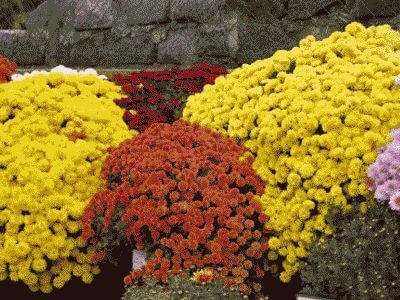

Their color range is very diverse. These flowers grow in the form of a shrub. It is a perennial plant. And another plus for these flowers is that they tolerate cold days well, they are quite frost-resistant. Although for the winter it is still better to shelter them from the cold. These plants attract the attention of flower growers by the fact that they are undemanding and easy enough to care for.
If it is decided that the chrysanthemum oak will grow on a plot of land without shelter, then you need to foresee that for the plant it was:
- enough sunlight
- windless side.
- The soil should be light enough. Organic fertilizers and sand can lighten the soil if it turns out to be heavy. In the airy and loose earth, which absorbs water well, the flower can take root faster and easier.
- For feeding oaks, it is better to use cow humus.
- Two weeks after planting the flowers, the first feeding is done.
- If you want to extend the flowering time of chrysanthemums, then you can use phosphorus fertilizers. By the way, this will make the leaves of the plant look greener, stronger and thicker.
- Potassium-phosphorus fertilizers should be fed to flowers during bud formation and during the entire flowering of oak trees.
- Foliar top dressing is best done with nitrogen fertilizers.
- During watering, water should not get on the leaves of the flowers.
- For beauty, it is necessary to trim the bushes in time.
Insects can also bring a lot of trouble to these beautiful flowers. To preserve such beauty, it is necessary to get rid of aphids. This must be done even before the buds form. Meadow bugs and spider mites also spoil oak flowers. Pesticides are suitable for controlling these pests.
So that the flowers can winter calmly and not freeze, you need to take care of them before the start of severe frosts. For this, the garden perennial chrysanthemum must be cut off. And the land around the bush needs to be piled up and treated with humic substances. With the onset of frost, the bush is covered with spruce or pine branches. It helps to protect the bush from wind and frost. Prevents rainfall. Helps to maintain a certain temperature regime. And the rodents will not be able to reach the flowers.
Chrysanthemum bush division
Dividing a bush is an easy way to reproduce chrysanthemums. Reproduction by dividing the bush begins in early June, or in late August - early September. For reproduction by dividing the bush, only strong, beautiful and healthy chrysanthemums, with developed inflorescences, are chosen. Choose healthy, pest-free chrysanthemum bushes.
The number of parts, when dividing a bush, depends on the age of the mother plant and varietal characteristics. summer bush of chrysanthemums gives To obtain "delenok", the mother bush is dug up and divided into parts that have shoots with roots. The resulting parts of the bush are immediately planted in open ground, placed in holes with humus and watered abundantly.
With the autumn breeding of chrysanthemums, young bushes must be covered for the winter with branches of oak, fir spruce branches or branches of thorny bushes without leaves.
Reproduction and cultivation of oak trees
The best time for planting or transplanting flowers comes after the last frost and cold are over. The last month of spring, May, is ideal for this event. Even the beginning of June will come up. It is necessary to plant these flowers in higher areas.
Best of all, these flowers can propagate using cuttings or separate parts of the bush, separated from the main bush.
It is necessary to determine the place and location of the plants. Then prepare the ground. And if previously grown cuttings are to be planted, then it is preferable to transfer the cuttings to the ground together with a lump of earth, so as not to damage the root system of the plant. If the plants in the flower beds were kept in a cool place, then they will need to stand in the open air for a week so that they can warm up. Plant small chrysanthemum bushes at a distance of twenty centimeters.
Shrub chrysanthemums grow very quickly. Over the season, they grow from a planting cuttings to a full-fledged bush. To give the bush a certain shape, you need to shape it. It is necessary to pinch the tops in early June. It is worth taking up the transplantation of large bushes of chrysanthemums if they have grown in the same place for three years. During the first year, after transplanting the bush to a new place, the land around the bush must be loosened constantly throughout the year. This is necessary for the flowers, since young shoots will appear faster and the bush itself will form.


It is also possible to transplant chrysanthemums in the autumn season, in an area where winters are not cold and there are no severe frosts. In such cases, it is necessary to transplant the cuttings before the onset of the first frost. To do this, you need to dig up the plant and cut off the old branches. Then separate the young.
Next, you need to prepare the soil, after fertilizing it. There should be no stagnant water in the holes. Then plant young cuttings. And don't forget to water. Over time, we cover the flowers, protecting them from the winter cold. To do this, you can use sawdust, peat, spruce branches, dry leaves. Large chrysanthemum bushes can also be transplanted into a suitable sized flower pot or bucket, as long as the plant and root system are not damaged. Leave the plant in a cool place. As soon as the pouring begins to wither, it will be necessary to cut the bush almost to the ground, leaving some fifteen centimeters. Leave the plant in this state until spring.
You can also try growing chrysanthemums using seeds. From the photo, you can pick up exactly those chrysanthemum seeds that you liked the most, and you want to breed at home. For sowing chrysanthemum seeds, it is necessary to prepare special boxes with the necessary soil. In February, in its last decade, or in March, you need to sow flower seeds in special boxes, which must be covered with glass from above.
This creates a greenhouse effect. Seven days later, sprouts appear. As soon as two leaves appeared on the plant, you must immediately transplant the flowers into pots. Two months is enough for the plant to grow up to twenty centimeters in height. Oak trees bloom in five months from the moment of their planting. In May, the seedlings are already planted in open land. To plant a young flower in the ground, you must choose the right weather.
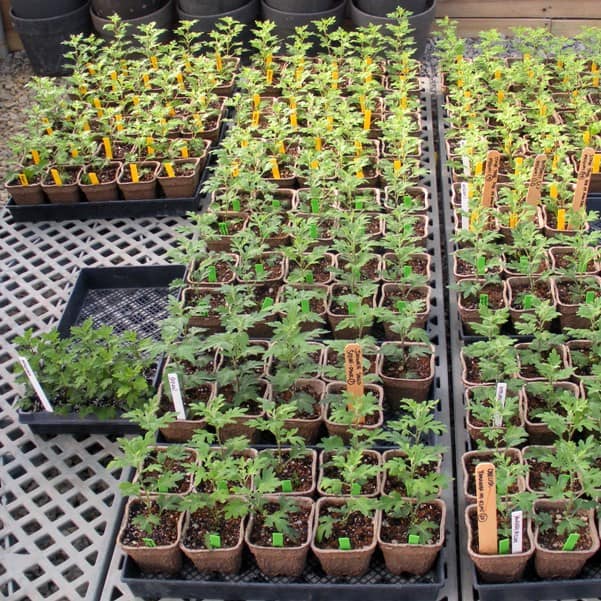

It can be a cloudy day, or better yet, a rainy day. To plant flowers, you need to make a trench. It's better than planting in holes. The distance between seedlings can be from twenty to thirty-five centimeters, depending on what kind of flowers. After planting and watering the plant, pinching is carried out, that is, the point of the flower sprout is removed.You can cover the seedlings and keep them covered until you are sure the flowers have started.
Now let's figure out where to transplant the oak.
Rational, would transplant the oak in a place with perspective. By perspective I mean a place where he will be comfortable throughout his long life, that is, a spacious place. For example, if you transplant an oak near a house, then it is better to do it at a distance of 20-40 meters from the house. Why? Because this is the approximate height of an adult oak tree. This is a safe distance in case oak branches break off in strong winds, stormy weather conditions or other circumstances, which will hardly happen. And the tree itself will feel better, the roots of which can allow themselves to grow.
Another reason to replant oak at a distance from home
Tips for florists
These flowers are unique and amazing. Today, more than six hundred and fifty species of these flowers are known. These are varieties of pompom, feathery, bristly, spherical, anemone, undersized, semi-double and double oak. They are annual and perennial. Each of the varieties is interesting in its own way. And caring for such flowers requires knowledge, diligence, desire and great love for flowers.
It so happens that the chrysanthemum has not bloomed. And the question immediately arises: why? And what to do? If by the fall your favorite chrysanthemum bush has not bloomed, then mistakes were made while caring for it. Typical mistakes include:
- lighting. Perhaps the sun's rays illuminated the plant for less than seven hours a day. And this light was too little for the flower. And it is possible that there was an overkill of lighting. When the plant has been exposed to light for more than ten hours. The plant is tired of this.
- A pinch made at the wrong time can also be one of the reasons why chrysanthemums do not bloom.
- Lack of fertilizers. It is necessary to feed the plant with phosphorus or potassium. The plant can be saved from the invasion of leaf rollers, slugs, caterpillars with ash, mustard, herbal infusion, and chemicals.
- The same drugs can get rid of powdery mildew, leaf spot, rust, chlorosis.
- A very large amount of moisture leads to fungal diseases in plants.
- Viral plant diseases lead to the fact that chrysanthemums began to wither abruptly. In this case, it is necessary to immediately dig up the diseased bush and burn it.
- If chrysanthemums were grown in a greenhouse, then they just need to be dug up for the winter period.
- For the winter, you can not hide chrysanthemums in the room, which are adapted to the winter cold.
Interestingly, chrysanthemums, in the language of flowers, are considered a reflection of longevity. And if you were presented with these amazing flowers, then know that it is from the bottom of your heart that you were wished long years of life. And it's worth a lot.
Read more about flower care here:
Korean chrysanthemums, or, as they are also called, oak flowers, are distinguished by their unpretentious care, have an attractive appearance, decorating the backyard with their flowering. Thanks to unpretentious care, every gardener will be able to cope with the cultivation of oak trees, and the variety of varieties will allow you to choose flowers that will fit the general color scheme of the flower garden and alpine slide.
Where else can you transplant the oak?
- to local city parks. Usually parks are only "FOR!" such proposals are verified by our own experience. At the same time, you contribute to the greening of the city and set a positive example for others. For maximum efficiency, take a few pictures of your event and share it on social networks so that the maximum number of people can see your work!
- fields. A great idea for scattering or replanting oak trees in no-man's fields. In the form of alleys or in any form. Imagine what beauty will be afterwards!
- invite someone from your acquaintances;
- Housing and communal services or UK. They willingly respond to such suggestions, and they will also say to you: "Thank you, come to us again!" (tested on personal experience);
- sanatoriums, health camps;
Description of the species
Korean chrysanthemums - perennial flowering plants, which can reach a height, depending on their variety, of 120 centimeters. The stems of oak trees are erect, thin, pubescent on top. In appearance, the leaves on the stems resemble oak, hence the name of these flowers. The flower buds are ligulate and tubular, located in the inflorescences of the baskets. During the flowering period, up to 400 inflorescences can open simultaneously on one full-sized bush.
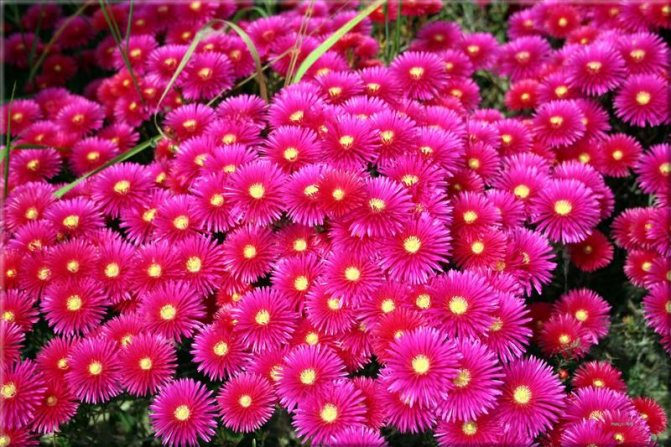

These are unpretentious flowers in care that easily take root on any type of soil, while they grow especially well and are decorative on loose, well-drained soil.
Chrysanthemums are light-loving plants, therefore, when choosing a site for a flower garden, you should remember that in the sun oak trees will differ in their maximum decorative effect. At the same time, every gardener and novice summer resident will be able to take care of oak trees.
Today gardeners know several hundred varieties of chrysanthemums, which are perfectly zoned for the Russian climate, are unpretentious in care and are distinguished by excellent decorativeness. Oak flowers, the care and reproduction of which is not difficult, make it easy to equip a full-fledged flower bed on a personal plot.
Common varieties include:
- Margarita is distinguished by snow-white flowers, and the height of the shrub can reach 70 centimeters. Flowering of this variety begins at the end of August and lasts until the very cold.
- Valentina Tereshkova. An unpretentious variety of oak trees to care for, which is distinguished by raspberry inflorescences and compact size of a shrub. Flowering begins in September and lasts 2-3 months.
- Spring sunset is a dwarf variety, the height of which usually does not exceed 50 centimeters. A feature of this variety is the characteristic raspberry red color of the inflorescences and the flowering duration, which is 3-4 months. The undersized spherical oak flowers of this variety will perfectly decorate the backyard.
- Modesty. A powerful shrub can reach a meter in width and 150 centimeters in height. Flowers of a delicate pink shade are 6 centimeters in diameter. Flowering begins at the end of August and continues until the coldest weather.
- Vivat botany. Chrysanthemum flowering of this variety lasts for 65 days. Oak flowers are semi-double, with a pronounced yellow color. The height of the shrub of this variety does not exceed 55 centimeters, which makes it possible to use this variety to create original small flower beds.
By purchasing high-quality planting material in specialized stores, you can be completely confident in the variety of flowers planted in a flower bed.
The gardener needs to remember that most varieties of oak trees are hybrids, so it will be impossible to get seeds from them on their own. When choosing a particular variety, it is necessary to take into account its size, flowering period, as well as cultivation techniques.
We cut right: not tops, but roots
What is the difference is not an idle question. Autumn cuttings are fundamentally different from spring-summer ones - and literally: for reproduction, the root shoot is used, it is also the root growth, shoots growing from the mother rhizome.
In the warm season, semi-lignified parts of the stem are used as material for cuttings, in the fall - shoots that awaken from root buds.
When to expect flowering by cutting chrysanthemums in the fall? When the procedure is carried out at the end of October, followed by planting in greenhouses, flowering occurs approximately at the beginning of April. When planting the harvested material in the spring, flowering will occur the next year or at a later date.
In early autumn, flower growers also practice the usual green cuttings of chrysanthemums. The method can be recommended exclusively as an experiment: not all varieties at this stage of the growing season are suitable for reproduction.
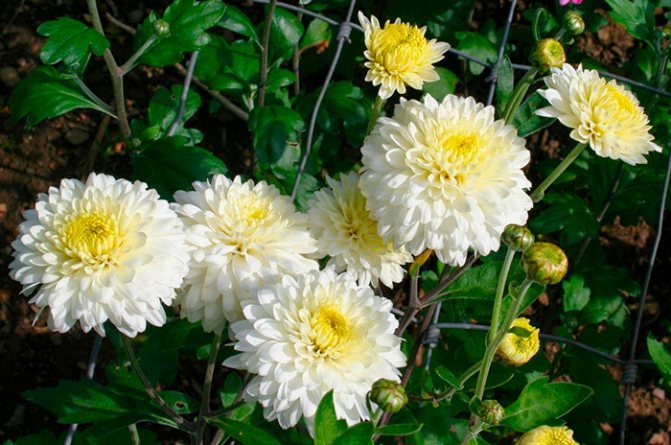

Rules for placing autumn flowers in a flower bed
Plants are placed on plots not chaotically, but in a special way. Order is required not so much for beauty as for allowing flowers to reach full maturity. When composing flower compositions, many characteristics are taken into account:
- flowering time;
- property to grow;
- availability for weeding.
Some flowers will help highlight lawns, hide outbuildings. Others will start to delight immediately after the snow melts. They often try to hide the autumn flowering a little, that is, to plant it further, behind those varieties that will fade earlier. Each plant has its own place, type of soil.
Names and characteristics of annual autumn flowers for flower beds
Annual flowers attract backyard owners with the ability to make annual changes to it. Every season you can experiment and admire new varieties and repeat your favorites.
Callistephus chinese
Annual aster
has more than 3 thousand varieties. You can find low or tall, austere and curvy, pale and bright. It is easy to choose for every taste and garden preference. Without frost, aster grows in winter, without losing its charm. Bright aster loves open spaces and sunlight.
Callistephus chinese
Croxomy
The plant belongs to the bulbous group. It does not require annual replanting.
The bush came from African countries. The inflorescence resembles Iris, but the location on the stem is incomparable with anything. The buds cling to the stem one after the other, some, fading, fall, others bloom at this time. The leaves of the shrub are xiphoid, dense and strong. The peduncle is strewn with bright red buds.
A bright bush is one of the must-haves on personal plots. The species diversity is also very wide. The height of some varieties reaches 1.5 m. The lowest are 20 cm. Chrysanthemums have inflorescences of different shapes - simple, mazre, needle-like, tubular. A perennial looks beautiful, combining several colors in one place. Flowerbeds with chrysanthemums amaze with the variety of bright colors of autumn and summer.
Dubki
A special type of chrysanthemum is Dubok.
The flower heads of Korean varieties are unusually colorful and beautiful. Lush terry hats, like oak trees, cover green bushes of small leaves and colorful unblown buds. Semi-double views surprise with delicate colors of summer before the coming winter.
Gelenium
A perennial is comparable to yellow daisies, but the core is voluminous and protruding outward. The petals can be more than just bright yellow. Autumn applies red and orange strokes on them. One gets the impression of a single bush, but in fact, it is a set of single plants.
Gelenium
Flowers of October
In October, the weather is significantly different from summer. Many plants in the garden have already faded, but it is the October autumn flowers that can give a real fairy tale. Among all, the following stand out:
Snapdragon (Dogs)
This plant is perennial, but it is more commonly used as an annual. It got its interesting name due to the unusual shape of the flowers that resemble the mouth of a lion. Snapdragon can be either tall, up to 80 cm, or completely dwarf, no higher than 20 cm.
Dogs are an unpretentious flower. Prefers light loamy soil, likes well-lit areas. If those inflorescences that have already faded are removed regularly without touching the leaves, this will lead to the development of lateral processes, which are usually abundantly strewn with colorful flowers.
Pansies or Viola
Delicate, graceful perennial garden culture. This stunted plant resembles a violet in the shape of flowers.The shade-resistant plant is distinguished by a wide and varied color range. Viola compositions are an excellent decoration for balconies and outdoor flowerpots.
Nasturtium
In order for the flower garden to please the eye, it is important to follow certain rules when placing ornamental plants.
- With the correct selection of plant species, the flower bed can bloom all year round.
- The small distance between the planted flowers can lead to the fact that they simply intertwine with each other, and this is not always beautiful.
- Plants in the same flower bed should be selected in such a way that they are in harmony with each other in size, color, and leaf shape. So, if you place too small and too large flowers next to it, then it will look rather unsuccessful than beautiful.
- Try to avoid the proximity of flowers with the so-called "basic colors" - red, blue, yellow.
- Between red and bright yellow flowers, white ones will look great. But the neighborhood of lemon-yellow shades in this option is best avoided.
- If possible, do not overload the site with a large variety of plants.
Growing conditions
This plant is a symbol of longevity. Regardless of the variety, all types of oak trees have very delicate and bright flowers. This perennial shrub is considered frost-hardy, however, it is better to cover it for the winter. The Chinese have been practicing this for many years.
Growing and planting oak trees is not difficult because these flowers are unpretentious. There are several reasons why gardeners choose these to decorate their garden.
- Oaks are not demanding on the ground. They can be planted in regular garden soil as long as it is well-drained. This should be a well-sunlit area, as flowers are very fond of bright lighting.
- The most available substances can be used as fertilizers - droppings, liquid mullein or vermicompost. Timely feeding of plants with nitrogen at the time of the formation of flower buds allows you to grow plants with strong stems and large leaves.
- Plants will need special care during the period of active growth of the bush. By cutting off the lower leaves on the plant, you can create a beautiful bush shape, as well as prevent the occurrence of many diseases. It is through the lower leaves that diseases are transmitted.
- After the plants have faded, the stems are pruned, leaving hemp up to 15 cm high from the ground.
That's all the care of oak trees, which will not be difficult even for novice florists.
Garden flowers that bloom in September
Dahlias
Unpretentious flowers have more than 20 thousand species. They are classified by bush shape, inflorescence type and color palette. Gardeners who want to admire the bright autumn buds are offered to choose from several varieties: piono - anemo - spherical, collar, needle, nymphaean. The dahlias will open at the end of August
will be decorated with bright heads until the first snow. If the buds are closed at night, they will not freeze and persist even longer. It is impossible not to notice the dahlias. The heads are large, they sit tightly on the legs
Aster
Late stars of different varieties are impressive. Annual species are large and spherical. Perennials are in bouquets. Varieties even have names that are close to autumn ones: september, october. Lush heads in different shades able to withstand a drop of up to 7 degrees
... The wide palette of colors pleased, the wondrous bitterness attracted.
The guest from Japan has taken root very well in Russia. Flower of the Land of the Rising Sun very thermophilic.
Breeders from Korea have developed a variety that is not afraid of cold temperatures. The palette is similar to the originals, but the aroma is bitter and wondrous.
Chrysanthemums
Colchicum
The graceful bells protruding from the ground before winter, when there are practically no flowering plants left, is surprising. The magical colchicums are reminiscent of the appearance of snowdrops. They protrude directly from the ground. The varieties are autumnal, magnificent.
Outwardly cute, gentle and magically fantastic.
Rudbeckia
Autumn daisies are comparable to little suns or sunflowers. In September, you can admire the dissected rudbeckia, in October - a glossy view.
rose flower
The queen of gardens is a favorite gardener. Breeders have created late varieties. Autumn roses are not so large, but attractive pink buds cover the stem with an almost continuous cover. Late varieties are no less attractive than earlier ones, but more adorable.
Asters
How to propagate oak trees on your own?
The propagation of oaks takes place with the help of seeds. To grow successfully, you need to know some rules in this process. Planting seeds should be carried out one year after they were harvested, since it is these seeds that have almost 100% germination. Planting material sown a month after collection may practically not emerge. The germination rate of such seeds is no more than 10%. The planted seeds should be watered periodically and shaded from the sun at midday. This is the main care of the seedlings.
In the future, when they grow up, they should be looked after in the same way as for adult plants.
In addition, oak cultivation is carried out using cuttings. The grafting process is carried out in the spring. Young, well-ripened shoots are cut to a length of about 15 cm, then lowered into the growth stimulator Kornevin and planted in the ground. Further care of the shoots consists in regular and moderate watering of the soil.
Adult specimens that require transplanting can also be divided and multiplied. This is a rather successful cultivation of oak trees using the bush division method. The bush is divided into two parts and planted separately. This rejuvenating treatment allows you to get two lush and brightly flowering plants from one.
How to buy Korean chrysanthemum seedlings
Buy one thing
a Korean chrysanthemum plant can be bought for 250 rubles. The minimum order amount can be 1500 rubles, but the cost of delivery by mail (or PEC) in this case is paid by you. Delivery by mail is free if the cost of plants (set) is
3000 rubles
... The maximum weight of one parcel is no more than 5 kg. The parcel is sent by the Russian Post of the 1st class or by the PEK transport company.
Other plants:
Any varieties of chamomile, as well as chrysanthemums, are indispensable in any garden. They bloom for a long time, are winter-hardy, their cultivation is simple and they can perfectly act as a tapeworm or in compositions with other tall flowers.
Gaillardia requires certain conditions when landing. Here you will find tips for planting, growing and caring for Gaillardia.
Ratibida "Sombrero" is a perennial flowering plant up to 70 cm high, originally from North America. We send a seedling of this plant by mail, with a closed root system.
Hybrid bearded iris is a powerful perennial plant that is not afraid of waterlogging, drought, or frost. Will grow in any corner of the garden - even in the sun, even in partial shade. The most unpretentious and very beautiful plant in your garden.
The fern, which has the additional name "Ostrich", is a shade-tolerant perennial plant. Ideal for decorating your garden along paths or fences.
A plant of such beauty as Echinacea purpurea is rarely found in our latitudes. Therefore, every gardener should grow such flowers.
Undoubtedly, chrysanthemums are the best decoration of the autumn garden. When everything around is already gray and unsightly, the bright flowers of chrysanthemums delight our eyes.
Chrysanthemums
are divided into several types. Let's leave these details for connoisseurs and professionals.
If you want more detailed information, you can easily find it on the Internet.
I’ll tell you how to effortlessly create for yourself a magnificent flower garden from these beautiful autumn flowers.
We will consider large-flowered chrysanthemums (Indian chrysanthemums) and small-flowered chrysanthemums (Korean chrysanthemums or oaks).
Care for chrysanthemums and oaks is about the same. The differences are small. The biggest difference is that large-flowered chrysanthemums tolerate winter frosts much worse.
Large-flowered chrysanthemums
usually grown in one stem, as well as three stems with one flower on each of them (but in this case the flowers will be smaller in size) For large-flowered chrysanthemums, it is very important to pinch on time. Pinching of this group is required, otherwise the primary bud will give a defective flower.
As soon as the young chrysanthemum releases the 8th leaf, you need to cut or pinch off the top. Then the plant will release several new shoots. Of these, you need to leave 2-3 of the strongest, and remove the rest.
Plucked chrysanthemum cuttings can be rooted, and later planted in the garden. Periodically, large-flowered chrysanthemums need to be pinned, removing unwanted shoots, and thus only one full-fledged flower is formed on each trunk.
Small-flowered chrysanthemums
- this is the kind of autumn flowers that even a negligent mistress can grow. And if you put in a little effort, your flower garden will be just gorgeous!
Korean chrysanthemums develop quickly and give a lot of growth. The planted stalk will soon become a massive bush, and in favorable conditions it will grow and expand further every year. But…
If you want to get a beautifully formed bush or form a flowering border along the path, I advise you to plant oak trees in the spring.
As soon as the young shoots (babies) reach a height of 10-15 cm in the spring, carefully dig up the uterine root and plant the shoots one at a time at a distance of 40-50 cm. They are quickly accepted and begin to grow. When the sprout reaches a height of 25-30 cm, pinch it (break off the top).
This is all the wisdom! By the fall, the shoot processed in this way will form into a fluffy bush, which will delight you all autumn until the very frost.
Chrysanthemum is very moisture-loving, therefore, the plant must be watered abundantly before flowering.
Lack of lighting of chrysanthemums leads to elongation of shoots, to weakening of plants and a shift in flowering periods characteristic of a given variety.
Chrysanthemums need sufficient nutrients for good growth and beautiful flowering. If the soil in your garden is infertile, then before planting it is advisable to add rotted manure, compost, peat.
How to grow oak flowers
Oaks are autumn flowers, like other chrysanthemums, bloom when the rest of the garden plants are already preparing for winter. Unpretentious oak trees adorn the garden until the very cold weather with their numerous bright flowers-caps.
Chrysanthemums, planting in spring and autumn
Please note that if you decide to grow chrysanthemums, planting and care in the open field differ in spring and autumn - with spring planting, mother plants and cuttings take root better, but in autumn you can choose a flowering bush and not be mistaken with its appearance.
In very frosty winters, choose the Korean small-flowered hybrids of chrysanthemums, which are nicknamed the oak - this species unites many varieties zoned in the middle lane and the Moscow region. Large-flowered Indian chrysanthemums are tall - they grow up to a meter, and sometimes up to one and a half, but they are afraid of cold weather and easily freeze out.
For chrysanthemums, choose a sunny, preferably elevated place. Flowers do not like stagnant moisture, therefore, the waterlogged soil is drained by adding a layer of coarse river sand to the planting hole. The soil is preferable slightly acidic or neutral, light and loose. Too dense - mixed with peat, humus or rotted compost.
Chrysanthemum plants are placed every 30-50 cm.A shallow hole is dug so that the shoots on the mother liquor or two-thirds of the cuttings are not covered with earth, when dividing the bush it is about 40 cm.No more than 0.5 kg of humus or compost is added to the hole. If you overdo it with fertilizers, the flowers will be small, and only foliage will be lush. It is recommended to water the roots with a stimulant (Epin, Kornevin, Heteroauxin), and then cover it with soil and compact it. After spring planting, it is advisable to cover the cuttings from the sun with a spunbond for a couple of weeks.
When planting in autumn, the chrysanthemum bush must be watered abundantly, this will compact the soil, eliminating voids in it, because of which the roots can freeze. In addition, the flowers are cut and a third of the stems are left for the nutrients to go into the development of the root system.

